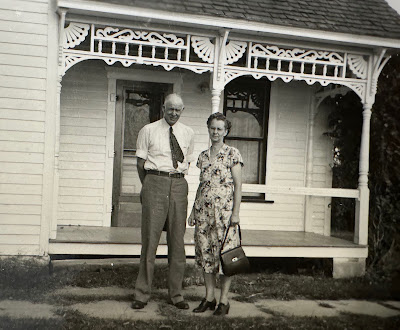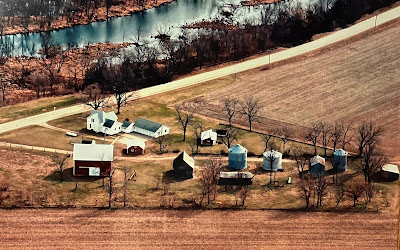The farm in southeast Iowa where I grew up had an old Victorian house with bullseye woodwork and stained glass and a big red barn with a running horse weathervane and glass lightning rod balls on the roof's ridgeline. It had sheds, corncribs and three chicken coops (a small brooder house for chicks, a bigger coop for laying hens and/or broilers and a third coop, for chicken overflow, I suppose). There were fruit trees (sour cherry, apple, apricot, pear, white peach and persimmon). There were strawberry, rhubarb and asparagus beds and a huge garden space, all the product of generations of a family who took self-sufficiency seriously.
And there were a lot of walnut trees. An approximate sh*t ton of walnut trees. That’s more than a crap load, in case you’re wondering. I never questioned why there were so many. They were just a fact of life. In the fall, I had to help pick up the fallen nuts because you could turn your ankle trying to walk on them.
Also, you do not want to know what happens when you hit the fallen nuts with a riding lawn mower. The result is akin to a chainsaw slasher movie, only instead of blood, everything within a 20-foot vicinity is splattered with ink-like walnut juice. If that happens to be the outbuilding you spent part of your summer scraping, priming and painting (white, of course), it’s all the more horrifying.
As a child, I helped (read: child labor under protest) my dad gather and run the walnuts through a hand-cranked corn sheller to remove the hulls and then they were dried, cracked and the nut meats picked out. After that, my mom proceeded to ruin years of perfectly good baked goods by putting black walnuts in everything. Once I learned to bake, I made it clear there would be no nuts in anything I made. I stand by that rule today. Walnuts have their place and it is NOT in chocolate chip cookies or brownies or quick bread or cake.
This summer, while cleaning out mom and dad's house, I decided to count the walnut trees for kicks. I quit when I got to 25 because I didn’t have the ambition to go stomping around in the grove behind the barn. So 25 is an approximation. There might be more. Or I might have counted the same one more than once, lost in a flashback of walnut gathering trauma . . . err . . . memories.
My dad’s sister, Aunt Joyce, recently shared the following story of the Hanson family walnut trees, my grandmother, Laurel, and how she nearly declared war on the U.S. Government as a result of them.
 |
Laurel (Gaskell) Hanson I love this picture - it looks like she's ready to head off on an adventure (not involving walnuts). |
These are my aunt's words (mildly edited by yours truly – cuz old editors never die, they just keep rewriting the text):
By Joyce Hanson Richter Sorensen
I can’t think of more patriotic Americans during World War II than my mother—Laurel—and Aunt Myrtle and Aunt Olive (Editor: Laurel, Myrtle and Olive were sisters). They followed the rules/regulations of rationing and did all they could to support the war effort by darning socks, making feed sack material dresses, saving all metals and fats and repairing everything they could. Aunt Olive worked at the Rock Island (Illinois) arsenal making ammunition.
And yet I well remember the one time their patriotism was put to a strong test. The three Gaskell women were in an uproar.
America was not at all prepared to go to war when the attack on Pearl Harbor forced it upon us. Our nation scrambled to find ways to provide the war materials and objects that were needed. One of the things needed were lots of guns, of all types, for our servicemen.
Our government turned to its people for help. One thing that was needed was a good strong, sturdy wood to use for the gun stocks of the M1 Garand rifle the infantry used. The wood they wanted was from a walnut tree and there was a lot of it in the pastures and forests of the Midwest. So the government sent out buyers to obtain all the walnut wood they could.
Now the problem was Mom and her sisters always collected the walnuts from those trees in the fall. They would pick them up by the bushels-full to use. They are a very hard-shelled nut about the size of a silver dollar, and when they grew, they had a thick, approximately one-half inch green soft husk covering the shell.
We would go as a family in the fall after the first hard freeze, when they fell, and pick them up. The folks (Editor: my grandparents, John and Laurel (Gaskell) Hanson) always knew which trees in their pasture and the neighbors’ produced the biggest and best nuts and we picked up lots—like 80 or 90 bushels of them. (Editor: That also qualifies as a sh*t ton, in case you were wondering.)
 |
John and Laurel (Gaskell) Hanson |
They were then spread out on the roof of several sheds and the chicken house to dry. The outer green husk would eventually turn dry and then we would put them through the old hand-crank corn sheller to take this off. You couldn’t take the green husk off until dry as it had a brown liquid that would stain your skin brown for several days.
Then the nuts were stored out of the ways of varmints and after the field work was done in the fall, it became a family project to get the nut meats out of the nut. They had a very hard shell and it took a hammer to crack them, so Dad would bring a big old heavy iron anvil onto our enclosed back porch and he or one of the boys would crack them. Then Mom and the rest of us kids would sit and pick out the nut meat. Not a hard job but very boring.
However, it was to the benefit of us all, as not only did Mom use them in cooking and nothing is better than cookies with black walnuts in them (Editor: clearly, this is not a genetic preference), but she also sold the bigger pieces and the money obtained always went toward Christmas presents for us kids. People in town would call and get their names on the list for nuts.
But then the government man came around and wanted to buy all the walnut trees over a certain size in the area. I think they would pay $10 a tree and that was good money in those days. But not the way my mom and her sisters saw it. They were willing to sell some of the trees but not all as they wanted the nuts for themselves. The government didn’t see it that way. They wanted the trees. End of discussion.
The women got pretty hot about it. Aunt Olive went to the Government War Office in Muscatine to protest. My peaceful, quiet mom wrote a letter to the War Office. All to no avail. They came and cut down most of the walnut trees in the area. And so, the ones that were left were either a stunted tree or had some defect. Those trees produced some nut but not many. And those trees were watched like hawks in the fall with signs up that kept “nut robbers” away.
However, there were other nuts we gathered in the fall, like hickory nuts, and they were in big demand. Aunt Olive was great in the woods and she located some places where the folks could go get them. Also, several years, they went down to where Uncle Charles lived south of us on the Iowa/Missouri border where there were some walnut trees he would scout for them. But that was a problem as it took gas to get down there.
Mom decided at that time that they were never going to be without walnut trees again, so she planted several bucketsful of nuts so they would grow into trees for her. She planted them all along the lane to get to the field on the other side of the railroad tracks. She would dig a hole, place a nut and them cover it up and put a small piece of wood over it so the squirrels wouldn’t dig it up. She wanted her walnut trees!
When some came up, she would water them in dry times. Unfortunately, she died before any of the trees got much more than several feet high.
 |
Laurel Hanson, quilting |
Those trees drove Frank, my brother, (Editor: my father) nuts. Literally. He purchased the farm after Mom’s death and Dad had moved to town—but Frank inherited lots and lots of walnuts. And they had lots and lots of nuts, which created some problems. His wife, Marie (Editor: my mom) would rake up piles of them to get them off the lawn and driveway and they would take them across the road and dump them into the pasture.
How Frank hated them, and those trees again got cut, but not for money or gun stocks this time. I know Aunt Myrtle also planted trees in their pasture. Believe me, it did no good to mention to those women that their walnut sacrifice was helping win the war. It was just a subject that wasn’t discussed.
(Editor: so it remains a family mystery, if my father cut the things down after he bought the farm from my grandparents, where did the 25 +/- current walnut trees came from? Some could have been planted by industrious and forgetful squirrels but there remains a line of them along the farm lane stretching out to the fields. Perhaps re-growth from trees that were cut but stumps not pulled? Clearly my grandmother was serious about always having walnuts at her disposal!)


No comments:
Post a Comment